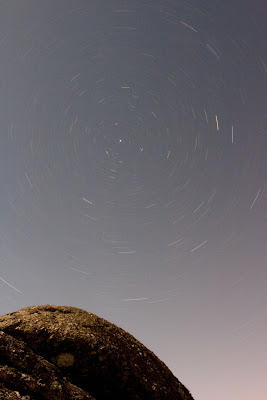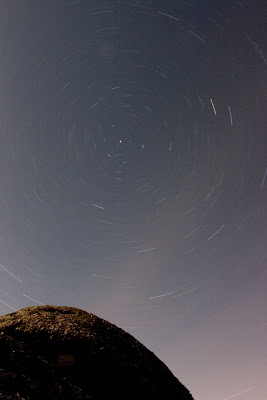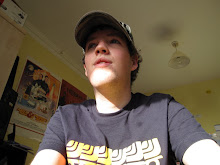As snowfall always gets me interested in going out, I decided to arrange a photo shoot for the evening of the 5th of March, as the weather looked clear and there would even be a nicely sized moon out which would help me navigate in the dark.
I watched the conditions during the day to make sure the sky was nice and clear by nightfall so the star photographs taken would be as clear as possible.
Recce Mission
The day before, I decided to venture up onto the moors in the evening on the 4th March (A Wednesday) to see what the situation was from the Burrator side of the Moor, up to Princetown. I headed out from Plymouth around 18:15pm and drove up to Yelverton and took the B3212 towards Princetown but as I arrived up on the top of Burrator I didn't see any snow, although when I pulled in, it did start to snow very heavily and after a few minutes of waiting I took these sample shots of the snow below to get an idea of how deep it was going to be...
These photos are shot on the road towards Moreton - Hampstead

 The reason I wanted to include the detail about the snow is because I want it to feature in one of my photographs, to give it a more wintry feel and more interest than just the stars and the foreground subject. As snow tends to boost the interest within a standard landscape photograph, I want to use this to my advantage and grab a decent photograph while the snow hangs around.
The reason I wanted to include the detail about the snow is because I want it to feature in one of my photographs, to give it a more wintry feel and more interest than just the stars and the foreground subject. As snow tends to boost the interest within a standard landscape photograph, I want to use this to my advantage and grab a decent photograph while the snow hangs around.Now all I had to do was wait until the next day and see how the weather changed and whether any more snow fell during the night...
Thursday 5th March 2009
On the Thursday I checked the web cam at Postbridge to see what the snow condition was like and there was loads up there, creating a very even, deep coverage of the fields around. It was also a very clear day on Thursday so I had confidence that the evening would be clear for some amazing star photography.
I travelled back to Newton Abbot and went from there up to the Tor at around 11pm with Alex to see if I could shoot some good photographs, here are some of the results from the evening:
The tor is located here:
Photograph 1
As the moon was up, the sky and surrounding areas where being lit in an almost 'creepy' way in how it was so bright, the snow was causing the moonlight to reflect and illuminate other objects.
Anyway as for the photograph, I set my camera up near the tor so I could have it as part of my composition while the star trails could still be seen above and to the right of the rock.
The first photo is shown here and the settings I used are below:
Photo Factfile
Shutter Speed: 29 Minutes

Aperture: f16
ISO: 200
I used f16 due to the incredible light being reflected back by the moon, it truly was difficult to work with this amount of light, although I did still manage to achieve this photograph which clearly shows the star trails moving around Polaris.
As for composition, I used to the top part of the tor to supplement the star trails but believe I would have achieved a better composition if I were to include more of the tor and move the trails to one side.
I used ISO 200 to try to avoid as much possible noise build up as possible, because as shutter speeds get longer, digital sensors do tend to pick up noise grain which can ruin the sharpness and quality of the star photograph which I am shooting.
For this photograph, I did have to boost the exposure in Lightroom to make the star trails more visible ( increased exposure to +2.0).
Now for the next photograph...
Photograph 2

For this one I decided to do a quicker 'sample' photograph to test the conditions, so I used the settings below:
Photo Factfile
Shutter Speed: 9.5 Minutes
Aperture: f8.0
ISO: 800
With these settings I achieved the photo on the right a lot quicker than the one above, which gave me an idea of what to do next with my remaining time and battery life!
I believe cutting the aperture to f8.0 was a wise move as it allowed more light into the camera which then resulted in more stars showing up.
Time for another photo...
Photograph 3

Retaining the high ISO number, I decided to revert back to the f16 setting to try to reduce the ambient lighting from causing flaring effects in my photograph.
Photo Factfile
Shutter Speed: 34 minutes
Aperture: f16
ISO: 400
The high ISO number gave the photo more illumination so that the star trails could easily be seen by the viewer.
I kept the same composition as I did look around to find a different shooting location and couldn't find an outcrop of rock which was high enough and also angled correctly towards Polaris.
Now time for the final photograph of the evening, shot at around 12:15AM so it was getting very late...
Photograph 4

My final photograph, I decided to try my best here and grab a photograph which I could take away and work with over the next few days in Photoshop and achieve a decent image as a result.
Photo Factfile
Shutter Speed: 38 minutes
Aperture: f16
ISO: 200
I went for the longest shutter speed I could considering the time of night it now was and the temperature was falling away to below freezing as the snow froze over and became solid.
Unfortunately as the shoot went on, I realised that I wouldn't be able to feature any in my photos as the angle would be too steep on the camera to include any lying on the ground at all, but I decided to shoot the photos regardless.
The Shoot Evaluation
The photoshoot went well for my second outing and also considering the temperatures that night, which were down around freezing towards midnight.
Composition
This has improved dramatically from the previous photo shoot which I featured on the blog a while ago as I have now attempted to move to the next step and include some foreground interest to grab the viewer's eye. In this setup, the foreground interest is the large granite outcrop of rock at the tor, which is then nicely positioned below the star trails to give maximum effect and not cover up too many of the trails which are visible.
Although I am happy with the composition, I believe I can find another location which has a more interesting subject to be the foreground interest, and more effectively leads the viewer's eye into the star trail above.
Exposure
This is still a slight problem for me as I haven't worked out an effective way to gauge how long the photo should be taken for, although I tried several different speeds and ISO ratings, I still need to develop a consistent method of checking how long the exposure will take and then using this as a guideline for shooting the photos.
This photo shoot resulted in many exposures being taken at unmatching times, giving me irregular results which are difficult to understand when processing.
So for my work to move forward, it needs to become more organised and more thought out so I can arrange the photos correctly when I arrive home.

No comments:
Post a Comment